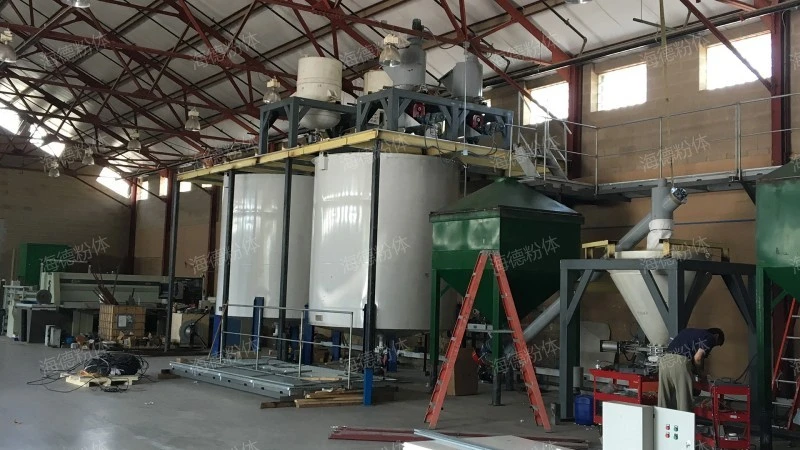Introduction and advantages of Titanium ore powder conveying system
Titanium ore powder conveying systemis a conveying technology that uses the energy of airflow to convey granular materials along the airflow direction in a closed pipeline.,is a Titanium ore powder conveying system,super quality and competitive price。
1、Brief introduction of Titanium ore powder conveying system
Titanium ore powder conveying systemis a material conveying system that combines jet technology and fluidization technology.,the main features are Operation safety, High conveying efficiency, Strong adaptability, High system reliability and convenient to use,it mainly includes control system, Bunker system, dust pelletizing system, Air source system and delivery system,Titanium ore powder conveying systemThe structural design is simple, novel and special.,in the course of work,Compressed air or other gases are passed through the air supply device to generate airflow, forming a certain airflow speed and pressure. Subsequently, the material is sent into the conveying pipeline through the feeding device, and under the action of the airflow, the material particles are suspended in the airflow or flow along the pipeline in groups. This gas-solid two-phase flow state enables materials to be transported to the target position along the pipeline. In the process of transportation, gas-solid separator (such as dust collector) is used to separate materials from air to ensure the quality of transported materials.,can be customized according to user's needs.。

Titanium ore powder conveying system
2、Titanium ore powder conveying system principle
Titanium ore powder conveying systemat the start of the operation,Mainly based on aerodynamic force, the continuous and stable transportation of granular materials is realized in a closed pipeline by using the energy of airflow.,generally, it is composed of Conveying pipeline system, control system, Air source system, dust pelletizing system, Bunker system and other major components,is designed by hyde powder with advanced technology。

Titanium ore powder conveying system
3、Introduction of advantages of Titanium ore powder conveying system
Titanium ore powder conveying systems have the following advantages.
- structure
- Totally enclosed conveying
- Multiple process operations can be carried out at the same time
- Easy to maintain
- Generality
The structure is relatively simple and the operation is very convenient. It can be transported flexibly in horizontal, vertical or inclined directions to adapt to different production environments.
The conveying pipeline can be flexibly configured according to the actual layout of the factory, which makes the process configuration of the factory equipment more reasonable, optimizes the production process and improves the labor productivity.
The Titanium ore powder conveying system system can not only realize the transportation of materials, but also carry out various technological operations at the same time, such as mixing, crushing, grading, drying and cooling. This versatility makes Titanium ore powder conveying systems widely used in many industries.
Although the initial investment of Titanium ore powder conveying system system may be high, its maintenance cost is relatively low. Because the equipment has simple structure and few moving parts, it is convenient to maintain and has low cost. In addition, after long-term operation, its efficient and stable conveying performance will also bring remarkable economic benefits to enterprises.
The Titanium ore powder conveying system system can transport a variety of materials, including powdery, granular, fibrous and small block materials, and has strong adaptability. At the same time, for materials with unstable chemical properties, inert gas can also be used for transportation to ensure the stability of materials during transportation.

Titanium ore powder conveying system
4、Titanium ore powder conveying system function
Titanium ore powder conveying systemmultifunctional, with functions such as Explosion-proof involves, Closed conveying, Environmental protection and pollution-free, material handling and Automatic control。

Titanium ore powder conveying system
5、Titanium ore powder conveying system characteristics
Titanium ore powder conveying systemfeatures include Avoid material pollution, Low energy consumption, Simple system, Operation safety and Easy maintenance,the principle is simple.Compressed air or other gases are passed through the air supply device to generate airflow, forming a certain airflow speed and pressure. Subsequently, the material is sent into the conveying pipeline through the feeding device, and under the action of the airflow, the material particles are suspended in the airflow or flow along the pipeline in groups. This gas-solid two-phase flow state enables materials to be transported to the target position along the pipeline.,It has the functions of cut down on energy consumption, Reduce pollution, Mixing and classification, Long distance transportation and Long-distance and multipoint transportation,is a Titanium ore powder conveying system newly developed by hyde。

Titanium ore powder conveying system
6、Brief introduction of Titanium ore powder conveying system
Titanium ore powder conveying systemis a process of transporting bulk materials from one or more sources to one or more destinations by using airflow as a transport medium.。

Titanium ore powder conveying system
Titanium ore powder conveying systemis a kind of high quality and low price Titanium ore powder conveying system,it has been widely used in logistics, heat-engine plant, chemical industry, environmental protection, metallurgy and other industries。
Related recommendation
-
What is a Double tube dense phase pneumatic conveying system?
2025-7-13 -
Introduction and functional advantages of Lithium nickel cobalt aluminate conveying equipment
2025-7-13 -
白炭黑气力输送
2014-3-12 -
Multi port feeding pneumatic conveying detailed introduction
2025-7-13 -
Introduction of Pneumatic conveying equipment for battery negative electrode materials
2025-7-13 -
Brief introduction and advantages of Sintering dust pneumatic conveying
2025-7-13 -
Introduction and functional advantages of Biomass fuel pellet pneumatic conveying
2025-7-13 -
Introduction of Vacuum pneumatic conveying equipment
2025-7-13 -
Introduction of Transportation of desulfurization and dust removal ash
2025-7-13 -
工程塑料气力输送
2014-3-12




